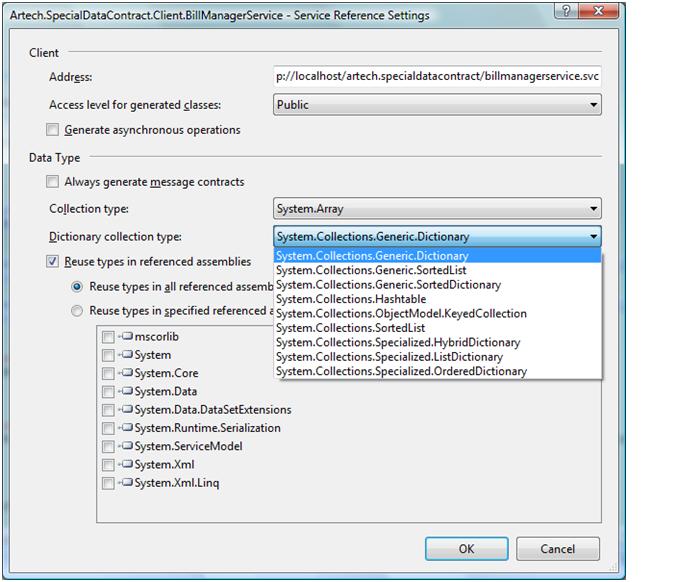談談WCF中的Data Contract(3):WCF Data Contract對Collection & Dictionary的支持
在本篇文章上一部分Order Processing的例子中,我們看到原本已Collection形式定義的DetailList屬性(public IList<TDetail> DetailList),在Data Contract中卻以Array的方式體現(public OrderDetail[] DetailList)。我們現在就來詳細地討論一下基於Collection & Dictionary 的Data Contract。
Data Contract for Collection
我們照例用例子來說明問題,在這裡我們創建一個批量處理Order的Service,於是我們創建了一個OrderCollection Type:
namespace Artech.SpecialDataContract.Contract
{
[DataContract]
public class Order
{
[DataMember]
public Guid OrderID
{ get; set; }
[DataMember]
public DateTime OrderDate
{ get; set; }
}
public class OrderCollection : List<Order>
{
}
}
下面是Service Contract的定義:
namespace Artech.SpecialDataContract.Contract
{
[ServiceContract]
public interface IOrderManager
{
[OperationContract(Name = "ProcessWithCollection")]
void Process(OrderCollection orders);
}
面是OrderCollection 在XSD中的呈現:
<?xml version="1.0" encoding="utf-8" ?>
<xs:schema elementFormDefault="qualified" targetNamespace="http://schemas.datacontract.org/2004/07/Artech.SpecialDataContract.Contract"
xmlns:xs="http://www.w3.org/2001/XMLSchema" xmlns:tns="http://schemas.datacontract.org/2004/07/Artech.SpecialDataContract.Contract"
xmlns:ser="http://schemas.microsoft.com/2003/10/Serialization/">
<xs:import schemaLocation="http://artech/Artech.SpecialDataContract/OrderManagerService.svc?xsd=xsd1"
namespace="http://schemas.microsoft.com/2003/10/Serialization/" />
<xs:complexType name="ArrayOfOrder">
<xs:sequence>
<xs:element minOccurs="0" maxOccurs="unbounded" name="Order" nillable="true" type="tns:Order" />
</xs:sequence>
</xs:complexType>
<xs:element name="ArrayOfOrder" nillable="true" type="tns:ArrayOfOrder"/>
<xs:complexType
name="Order">
<xs:sequence>
<xs:element minOccurs="0" name="OrderDate" type="xs:dateTime"/>
<xs:element
minOccurs="0" name="OrderID" type="ser:guid"/>
</xs:sequence>
</xs:complexType>
<xs:element
name="Order" nillable="true" type="tns:Order"/>
</xs:schema>
加上通過Add Service Reference默認生成的Class,我們可以很清楚地看出Collection是以Array的形式呈現的(Artech.SpecialDataContract.Client.OrderManagerService.Order[] orders):
[System.CodeDom.Compiler.GeneratedCodeAttribute("System.ServiceModel", "3.0.0.0")]
[System.ServiceModel.ServiceContractAttribute(ConfigurationName="OrderManagerService.IOrderManager")]
public interface IOrderManager {
[System.ServiceModel.OperationContractAttribute(Action="http://tempuri.org/IOrderManager/ProcessWithCollection", ReplyAction="http://tempuri.org/IOrderManager/ProcessWithCollectionResponse")]
void ProcessWithCollection(Artech.SpecialDataContract.Client.OrderManagerService.Order[] orders);
}
因為Array相對很Common的數據類型,基本上所有的廠商均提供了對Array的支持,這也是WCF在通過Add Service Reference生成Client端代碼的時候,會生成Array的原因。不過並不是我們只有唯一的選擇,事實上VS為此提供了擴展,允許我們對於基於Collection 的Data Contract生成我們需要的各種類型,我們只需要在Add Service Reference的時候選擇“Configure Service Reference”進行相應的配置:
通過上面的截圖,我們發現在Collection Type一項我們有若干選項,我們可以選擇我們希望生成的數據類型:Array,ArrayList,LinkedList,Generic List,Collection和BindingList。
Data Contract for Dictionary
前面的內容,我們分別討論了基於Generic和Collection的Data Contract,接下來,我們來討論最後一個特殊的數據類型的Data Contract:Dictionary。
延續上面的Order Batch Processing的例子,不過我們現在處理的不是一個OrderCollection對象,而是一個Dictionary對象,線面是Service Contract和Order的定義:
namespace Artech.SpecialDataContract.Contract
{
[ServiceContract]
public interface IOrderManager
{
[OperationContract(Name = "ProcessWithCollection")]
void Process(OrderCollection orders);
[OperationContract(Name = "ProcessWithDictionary")]
void Process(IDictionary<Guid, Order> orders);
}
}
[DataContract]
public class Order
{
[DataMember]
public Guid OrderID
{ get; set; }
[DataMember]
public DateTime OrderDate
{ get; set; }
}
閒話少說,我們來看XSD:
<?xml version="1.0" encoding="utf-8"?>
<xs:schema elementFormDefault="qualified" targetNamespace="http://schemas.microsoft.com/2003/10/Serialization/Arrays" xmlns:xs="http://www.w3.org/2001/XMLSchema" xmlns:tns="http://schemas.microsoft.com/2003/10/Serialization/Arrays" xmlns:ser="http://schemas.microsoft.com/2003/10/Serialization/">
<xs:import schemaLocation="http://artech/Artech.SpecialDataContract/OrderManagerService.svc?xsd=xsd1" namespace="http://schemas.microsoft.com/2003/10/Serialization/"/>
<xs:import schemaLocation="http://artech/Artech.SpecialDataContract/OrderManagerService.svc?xsd=xsd2" namespace="http://schemas.datacontract.org/2004/07/Artech.SpecialDataContract.Contract"/>
<xs:complexType name="ArrayOfKeyValueOfguidOrder_SkVQi6O3">
<xs:annotation>
<xs:appinfo>
<IsDictionary xmlns="http://schemas.microsoft.com/2003/10/Serialization/">true</IsDictionary>
</xs:appinfo>
</xs:annotation>
<xs:sequence>
<xs:element minOccurs="0" maxOccurs="unbounded" name="KeyValueOfguidOrder_SkVQi6O3">
<xs:complexType>
<xs:sequence>
<xs:element name="Key" type="ser:guid"/>
<xs:element name="Value" nillable="true" type="q1:Order" xmlns:q1="http://schemas.datacontract.org/2004/07/Artech.SpecialDataContract.Contract"/>
</xs:sequence>
</xs:complexType>
</xs:element>
</xs:sequence>
</xs:complexType>
<xs:element name="ArrayOfKeyValueOfguidOrder_SkVQi6O3" nillable="true" type="tns:ArrayOfKeyValueOfguidOrder_SkVQi6O3"/>
</xs:schema>
Data Contract的名稱為ArrayOfKeyValueOfguidOrder_SkVQi6O3=ArrayOfKeyValueOf+guid(Key的類型)+Order(Value)+_SkVQi6O3(Hash Value)。從該XSD的結構我們不難看出,只是一個數組,每個元素為Key-Value pair。
我們照例看看通過Add Service Reference方式生成的Client端code中的對應的定義:
[System.CodeDom.Compiler.GeneratedCodeAttribute("System.ServiceModel", "3.0.0.0")]
[System.ServiceModel.ServiceContractAttribute(ConfigurationName="OrderManagerService.IOrderManager")]
public interface IOrderManager {
[System.ServiceModel.OperationContractAttribute(Action="http://tempuri.org/IOrderManager/ProcessWithDictionary", ReplyAction="http://tempuri.org/IOrderManager/ProcessWithDictionaryResponse")]
void ProcessWithDictionary(System.Collections.Generic.Dictionary<System.Guid, Artech.SpecialDataContract.Client.OrderManagerService.Order> orders);
}
生成的是一個System.Collections.Generic.Dictionary類型。同Collection一樣,也依然可以有多種選擇:
